Lessons From Disney’s Zootopia
Disney’s Zootopia has quickly climbed to the number one spot of… well, pretty much every list, it seems like. An incredible score of 98% on Rottentomatos, 8.4/10 on imdb and it even broke Frozen’s opening week box office record (gasp). So, what is it that so many people like about this film? Let’s take a look at what makes Zootopia special and what we as animators can learn from it.
Design – a hint of (post-)golden age Disney
The film borrows heavily from the beautiful design language that Disney artists collectively developed over half a century. The current Disney animation crew took some the best elements from classics like Robin Hood or Bambi – they had a close look at how legends like Milt Kahl and Glen Keane fill their characters with energy, and transported it into 3D. Such a flow and rhythm rarely seen in CGI.
While 3D is fantastic at keeping volumes realistic, it becomes very problematic if you want to let energy flow throughout the whole character. There is often a rig limitation in the way that makes it seem… stiff. Not here, though. Elbow and shoulder lines are just exactly as pointy or flowy as they need to be. The line of action goes through the whole body (and some secondary lines through legs and arms), but there are also some intentionally placed points and straights to contrast the flow – just like it would come out of the pencil of an old Disney legend. Even the cloth simulation is on board with that: Look how the fox’s sleeves stand out just as much or as little as they need to, instead of doing whatever simulated gravity tells it to do.
Plus, but I am sure you already noticed, the character designs are unbelievably cute and charming. The internet branded the film as “the movie for furries” way before the release, which made me notice that there hasn’t been a film with such a strong (and well made) “animals that live like humans” theme for years. Well, this one is surely a winner when it comes to furry animal design, and it’s because the designers, modelers and riggers actually invested an insane attention to detail to translate this appealing look from 2D to 3D.
Zootopia is shaped by its inhabitants: It is split up into different climate zones, the trains have small, medium and large doors, a smoothie booth is shown with a pipe used to take drinks up to giraffe customers, cars come in all shapes and sizes to fit their drivers, and there is even an entire neighborhood that is miniature – perfect for its rodent population. This is an explosion of creative ideas only possible in animation. It’s also interesting to see those cartoony designs from older times interact with smartphones and computers. For once the mandatory pop-song at the end of the film actually feels like it comes out of this world. The mix between a timeless message in a modern environment is a refreshing view.
Story – by the books but from the heart
Alright, it looks good, but what about the story? It was really, really good! Was it something we have never seen before? Well… actually… no.
Right from the beginning it’s pretty obvious that this is another “you can achieve your dream if you try hard enough” film. And while I could understand how someone might not be in the mood to hear this yet again, Zootopia is one of the best takes on this classic story that has been done in a long time. Sprinkled with some crime mystery on top and very charming characters, this is a real treat.
And the filmmakers didn’t make it easy for Judy, a bunny who wants to be the first bunny cop. She hits brick walls on her path, even seems to genuinely give up for a short moment (which is rare in cartoons) and then in the end succeeds through an actual achievement – not just by believing in herself (I am looking at you Dreamworks’ Turbo). We have plenty of time to witness how hard Judy works and how kind she is. We are not just told this, we see it. And then we see how she is treated unfairly, has to fight and wins, but then there is a big flip side to the coin that has to be sorted out. Classic storytelling, masterfully executed. It fits ancient storytelling structures, but it still feels like all came from the heart.
Why reinvent the wheel if we already found out that round wheels are the best? Frozen drove on triangles, Big Hero 6 on squares and Tangled on hexagons. Now, finally, we get a Disney story that flows how a story is supposed to flow.
On top of that, we get one of the most prepared twists in the history of twists. It almost seems like they were taunting the controversial villain “twist” in Frozen. Literally, from the first scene on we start to collect puzzle pieces. Every scene has it’s place, has a reason and triggers the events that follow. And seeing it all fall into place in the end is a pure delight (Okay, you might be able to guess some parts of the puzzle’s picture before the characters, but for me that was fun too, because it had some nice “Oh no!”-moments).
Genre-wise Zootopia is a crime mystery with a hint action and several splashes of comedy. While this is kind of a trope area for live action, the creators make full use of the playground that is animation. Only in animation and comics can a crime have fantasy elements that effect the whole city so quickly. For some children, this might be the first time they experience a crime mystery story and adults can enjoy quite a few allusions to known TV series and film classics.
While the actual secret is a bit simple after we are given all the puzzle pieces, the filmmakers mange to keep up the tension and variety. We get some witty teasing between the main characters, a lot of intense investigation and unusual action scenes.
The few logic holes and story conveniences (why are those people there at this exact moment?) can be generally ignored because the characters are just so charming and you just want the story to continue. This is a weird fact I have observed over the years, but it keeps surprising me – if the characters are charming and have a wonderful chemistry, you can forgive almost everything (like the “The Sword in the Stone”, which is so wonderful because of the characters, but the story is actually pretty weak).
Theme
The theme of the film is just as old and familiar as the story: It’s all about being tolerant and avoiding prejudice – nothing that should be new to anyone. And given that racism and bigotry sadly are still alive and well, all around the world, it makes the film highly contemporary, while taking a timeless look at human nature.
The film also brings up “accidental” discrimination – how each and every one of us might say something insensitive without any bad intentions. The movie has quite a few jokes about such awkward situations, some of which adults will understand more than kids. In one key scene even our kind protagonist says something without thinking about it first and it’s painful to see how the situation goes downhill. Far further and sincerely downhill than most kids films would take it. A bold decision that pays of with an invested audience.
Well, actually, some of the younger kids in the audience might start to get a bit bored and restless during the more talkative parts of the movie (at least they did in the theater I was in). They seemed to enjoy the action scenes, but some of the psychological drama that I found so captivating, might have gone a bit over their head.
Characters
A big contribution to the story’s drive is the dynamic pairing of the two main characters. Judy, the optimistic and idealistic bunny from the prey side of the world, and Nick the fox, a scam artist who came to terms with life’s rough edges on the predator side. This setup alone has constant conflicts built into it, a vital ingredient for fantastic acting.
In some interviews the directors reveal that they decided to make Judy to the main character instead of Nick after animation had already started. This was a very bold and risky move that ended up being the perfect decision. Seeing the world from her perspective just allows for so much more conflict and development and, therefore, allows the audience to identify with her better.
Animation
The animation in Zootopia is absolutely delightful and a lot of fun. Actually, even the weaker Disney films were always brilliantly animated. Unlike the weaker films, though, the characters are actually given great material for very believable acting performances. Because the story is so very well structured, the characters never run out of objectives and obstacles, which are the foundation of every decent acting performance. On top of that, the animators take the pressure on the characters to the maximum, and because it feels authentic, we feel with them.
Visually, the animators continue what the designers started. Not only the models contain an excellent design language, but every pose is filled with rhythm, flow and energy. Some shapes especially around the shoulder come and go when needed just like they would in a drawing (this can be extremely tricky in 3D).
So many animals have tails, which allows for some especially pronounced lines of action, and Judy’s long bunny ears extend her emotions so wonderfully. I can’t wait until I can study some scenes frame by frame.
It’s also remarkable how every animal in Zootopia moves and walks differently depending on the species and personality (and there is a lot of walking and running in this film, so there’s a lot to take in).
But I don’t want to go on forever… We might have a detailed look at some specific scenes at a later point in time. In my opinion, there are a ton of great elements in Zootopia and the praise is well-deserved.
Let’s conclude with some of the lessons we can learn from it…
- Always strive for as much rhythm and flow in your design and poses as possible. Look for opportunities to make an arc run through arms, shoulders and legs, but set some well-placed points and edges for contrast.
- Make sure the world of the film fits to their inhabitants and vice versa.
- You can use tested and classic story structures as long as the characters and theme come genuinely from the heart.
- If a story develops in another direction, be brave and see if the new approach would work better.
Have you seen the movie yet? What aspects stood out to you? Do you agree with the positive reviews? Share your views in the comments!


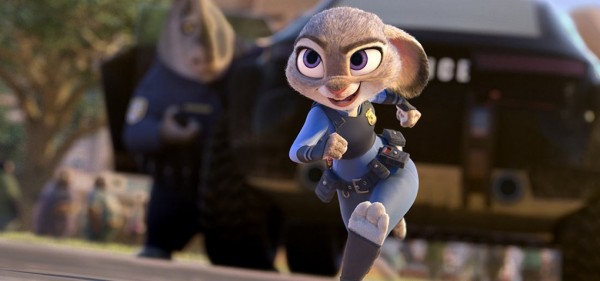
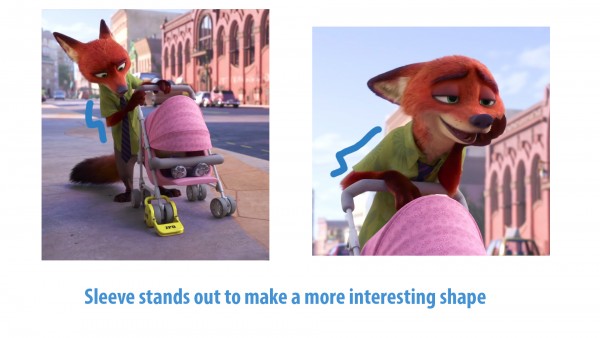
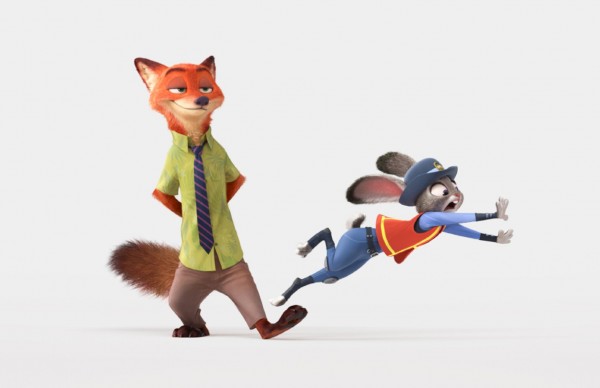
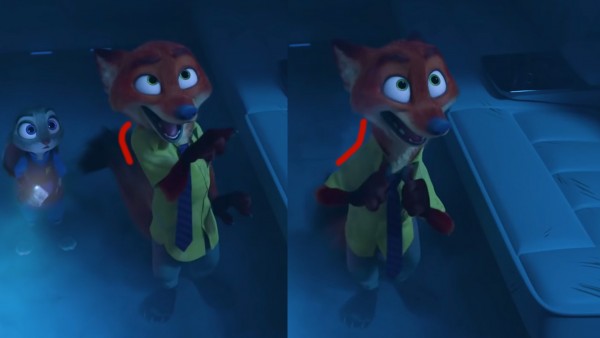
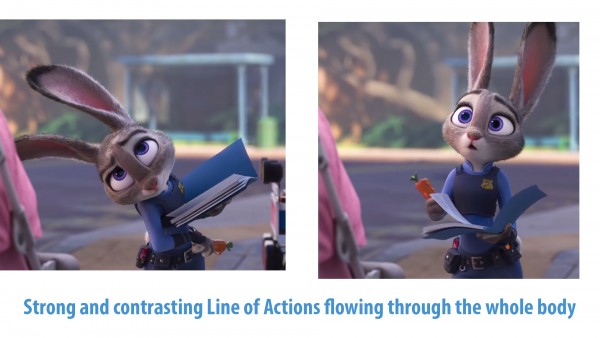

Hi,
Great article. I loved the film and will be looking forward for a more detailed analysis of specific scenes.
The following sentence got me a bit confused tho:
“Frozen drove on triangles, Big Hero 6 on squares and Tangled on hexagons. Now, finally, we get a Disney story that flows how a story is supposed to flow.”
Could you please explain a bit more the meaning of this sentence? Thanks.
Hi Duran,
thanks for your feedback. I would love to dive into more detail as soon as I have the DVD.
In this sentence I am comparing how bumpy and unfinished these recent Disney movies felt to me.
– Frozen: I know, many people love this film and I can understand that, but its story structure is a mess. First of all the film has a problem in tone, pretending to be oh so unusual and post-modern and then chickens out by closing with an uninspired happy end. For example, by teaching us how you shouldn’t fall in love with the first guy you meet – only to then go with the second guy that she knew for only two days. The problem of two potential perfect men was avoided by turning one evil in an unprepared twist (there should always be hints for a twist beforehand). Wouldn’t it be interesting to actually have her make a difficult choice? Or choose to be independent and get to know Christoph a little more first?
Then there is the trolls which are used just for random magic exposition without actually helping and have a return in a song that is a complete unnecessary show stopper. Here you can see JK and me rambling on and on about Frozen: https://www.youtube.com/watch?v=v8oIyUp_JDE
– Big Hero 6: Was a little better but still had some major flaws. Especially the exposition doesn’t come together right. He is into robotics, but has never seen the robotic lab of his brother? He is skilled at building robots, but has never considered studying it? Killing off the brother seemed very forced. As Ed Hooks noted in his acting review there are large parts without acting just showing cool super hero skills to sell toys. It had very cute and good scenes, but overall the story seems to be a product of market research, not of one creators passionate vision.
– Tangled is a bit more difficult to grasp. Here you can definitely feel passion at work, it just feels a little patched together at times. Especially the exposition bothered me. A “cool” voice over introduction telling us about something that both the protagonist probably didn’t ever know in this detail? I wonder if it would have been fun to piece the myth behind her hair together during the course of the movie. Because of Glen Keane’s influence the movie is an animation delight and there are many charming scenes but it all comes together a bit too rough and kitschy without real substance (and this is where it falls flat compared to Zootopia).
I am not saying that these movies are not enjoyable, I had fun during all of them. I just think that Zootopia is a little more refined structurally and has some more authentic substance that other movies are lacking.
Allow me to correct you on the inaccuracies you made in your post;
-Frozen: So you preferred a sad ending to a Disney movie aimed at kids? Never going to happen. Frozen had it’s cake and ate it too, which is why in my opinion it is better than every single Disney animated film ever released. It has an objectively superior plot to almost every single Disney animated film that came previously. To demonstrate this allow me to explain these misunderstandings you have.
The princess and the second guy went through plenty of trials and tribulations together, and this guy also saved her life on more than one occasion. She has gotten to know him far more than she ever knew the prince in those 2 days. And what did it amount to? A single kiss. For all you know they could have broken up the day after. The moral of not trusting a guy you just met stands unaffected by this scene. As for the twist, allow me to enlighten you on the clues that you have obviously missed;
1. Love is An Open Door – The prince gestures towards Arendelle when he sings about finding his won place
2. The prince hesitates when he noticed the chandelier was about to fall on the Queen
3. The prince did not arrest or do anything to the Duke despite knowing full well that he tried to kill the Queen in the ice castle.
So, judging by the amount of factual inaccuracies in this post I’m guessing you made tons of incorrect claims in your YT ramblings (don’t have the time to go through and address every one of these currently), showcasing a distinct lack of understanding and attention on your part for the films that you watch. Don’t take this as an insult, take this as constructive criticism, I appreciate the work you and J.K have put into developing this site. I recommend paying more attention to the films you watch and rewatch them to gain a deeper understanding if you happen to have questions. Tangled, another Disney animated film I rank very highly (in fact on par with Frozen), had some minor plot issues that could have been ironed out such as one moment of deus ex machina. I have not had the time to see Zootopia yet and I’ll be probably awaiting the DVD instead of going to theaters but I’ll be pleasantly surprised if this film is objectively superior to either Tangled or Frozen. As for BH6 that was one of my least favorite animated films in long time so I can’t help you with your questions as I kinda blocked it out.
Anyway thanks for doing this write-up and I look forward to future pieces.
First, to be clear about this: I hate and love Frozen. I love it because, yes, it has a superior and unique approach to many things. The setup is promising, I love the sister love twist, I adore the animation. I hate it because it could have been so much better. With a bad movie I wouldn’t care, but with an okayish movie that could have been something really extraordinary, I am very strict. Many things that Frozen attempts are brilliant, I just wish they would have combined it to something more finely composed and not pulled back from so many things. It has all these amazing ideas Disney never did before and the time is right for them, but I think there are just to many hastily patched gaps. And for different people these patches mean less or more.
With uninspired happy end I didn’t mean I want no happy end. Only a more complex/unusual one would have been nice. Remember Jungle Book? Mowgli leaving the jungle although he said he wouldn’t. That’s something that gives you a deeper experience than just him staying there. And it’s not even that complex, just a shift from want to need.
I guess what bothered me most is that they have this brilliant “oh it’s really about love between two sisters” twist, which could reveal the real theme of the movie. But they water it down by wrapping up the Christoph-Anna love plot directly after. Which is an okay choice they can make, sure, but I feel like they threw something special away to end it the ordinary way. I would have loved to have seen an end that’s more about the sisters. Maybe reliving the missed childhood more explicitly. For some the scene at the end might be enough, I found it a bit too vague.
I am afraid I saw these enlightening “clues”, but there are some moments that tell us the opposite. When Hans is alone under the boat for example he gives a loving smile when no one is watching – not a “my plan will work” or “I have a plan now” smile. They could have shown a more telling gesture or cut that shot. In the scene where they get to know each other there is also no indication that he recognized Anna. Either his plan was different at that time or he is a really good actor or a psychopath. Or why don’t even make it more complicated, he could have really loved her but his desire for the throne is stronger… he seems to battle no conflict when he betrays her. It’s not just me saying this, Ed Hook’s verdict of these and similiar scenes is the same. His plan and keeping him as a surprise villain can make a great story, but animating him so genuinely in love is very explicit for a false lead. The best false leads are ambiguous. The series Steven Universe for example manages to hide twists and surprises right in front of you for half a season in every single episode – it can be done! And if you burry hints in a way that even professionals don’t catch them the first time, you might as well not do that because 6 year olds will probably not see them either. It’s good to see and understand more the second time, but at least all the pieces of the main story puzzle should be easy to grasp. The old Disney films might have exaggerated that with a 3 times rule.
I have heard some anecdotes from people who worked on Frozen that some things during production were quite bumpy. For example they battled with how to fit the trolls into all this and I think it shows. We have this moody opening with the ice cutters that serves no purpose in the rest of the films, instead the trolls are suddenly Christoph’s family (and yeah I saw the enlightening hint that he is kinda separate from them). The troll “explaining” Elsa’s powers seemed so forced to me. There are hints of more (“cursed or by birth”), but it’s never picked up. And of course there is a free memory erase spell conveniently included.
And please, JK and I put a lot of effort into this website, but we are still humans. We watch what we review several times (and sadly in the cinema we cannot pause, rewind to dig out that enlightening clues that we missed) and try to give reasons for our thinking. Of course many things in art come down to taste and taste can be different and that is fine. JK for example doesn’t like how the positions of the characters during the finale scene in the stormy landscape doesn’t make sense, which is objectively true but didn’t break the scene for me. And if the little hints at Hans’ true intentions are enough for you that’s totally okay. Same with the trails and tribulations to fall in love. Yeah classically that is enough for fictional characters to fall in love, but after Elsa destroys the cliche of love at first sight I was hoping so much that it would keep going in new directions. Instead they ended up with the “two days of adventures and we are a couple” trope, doable and legitimate but not the groundbreaking better path that I felt was promised in the exposition. (Zootopia by the way did this better, there is probably a couple at the end, but it’s irrelevant to the story and therefor not shown).
Anyway, let’s nicely discuss this without accusing other people of not watching a film the right way. I can see why you think this way about it and I don’t disagree with you in some points at all. I tend to look for flaws in films and play the devil’s advocat because I want to learn for my own film-making. A film is always a patchwork of compromises and priorities (sometimes because of technology sometimes because an idea was still hiding). And on the other side there are viewers that all have different priorities and expectations as well. That’s how it is. I guess I was a bit to harsh about Frozen in my comment. It’s just so weird how the flaws in Frozen bother me so much and the flaws in Zootopia bother me so little. Ultimately, this might just be… taste?
Hello again Mr. Ferdinand. I thought my post wasn’t going to be approved seeing as it didn’t show up a day after I made it. Good to see that you can take criticism and feedback without censoring dissenting views. I enjoyed reading your passionate response, however I didn’t think these “hastily patched gaps” that seems to have drastically affected your opinion detracted from the film in the slightest. There was nothing wrong objectively with any aspect of the plot (I’ll be getting to that in a minute), but that doesn’t detract from your opinion on the film. So while you’re totally right that this might ultimately boil down to taste, objective analysis of any film is always possible. Keep in mind though that when you’re talking objective, all you can discuss are facts, not opinions, and that limits any objective analysis to merely finding flaws that are illogical within the context of the film. Frozen is certainly not flawless as it does have several errors in the animation for instance. But that is all you’re about to find. The story is cinched so tightly that there are absolutely no plot holes throughout it’s runtime, and that is what makes it superior to previous Disney animated flicks as well as Big Hero 6.
So let’s first address the factual inaccuracies that you have made once again. You claim that you saw these clues but in your earlier response you claimed this twist is “unprepared”, and “there should always be hints for a twist beforehand”, implying you have not seen these clues. If you did see these clues then the twist isn’t “unprepared.” It’s either one or the other. Now we come to the prince’s smile. Him smiling could be interpreted as a happy smile that his plan to “find his own place” is beginning to work. Not necessarily a smile because he loved Anna. Nobody could objectively state what is going through Hans’s mind at the time. And you’re right, Hans was portrayed as a very realistic sociopath. Welcome to the real world, where villains don’t sing elaborate songs announcing their intentions to the world. Hans behaves exactly like a real world sociopath would in his shoes. Your alternative of the prince being in love with the princess from the beginning is a good one and would have presented a moral conflict but sacrifices his realistic aspect, unless their relationship is built up over many days and culminates in this decision, which in turn would require a much longer runtime. So while there’s nothing objectively wrong with this twist, I agree that the clues would fly over the head of children. There’s a flip side to this though, six-year olds wouldn’t need to understand these clues anyway as they are not likely to understand what makes a good plot twists at that age. Frozen may have a young target demographic but it is, at it’s core, a family film. There’s something for everyone in it. All it would take is a keen eye and a good understanding of the plot to spot them, not a professional. Having never watched this tv show I am in no position to compare them though, but I have to say I prefer realistic villains to the over-the-top villains with elaborate songs in previous Disney films that only make themselves look stupid. Scar and Jafar are prime examples of stupidity, but that’s for another discussion.
Onto your next point, production was indeed bumpy. You are right about that. Here’s where you’re wrong. The first song foreshadowed the events of the rest of the film, established some background on the young boy and his reindeer and even explained the ice magic. Pay attention to the lyrics and you’ll realize that it does serve a very important purpose in the film. That explains why the trolls never elaborated on it, because it is assumed the audience did pay attention to the lyrics. Also what about the memory erase spell is forced? The trolls are magical creatures not unlike magical beings in any Disney film, and only one troll (Pabbie) was established to have this erasing spell. There’s nothing out of the ordinary about this, and it’s certainly convenient to the plot but so is every magical solution in any movie, Disney or otherwise. Not quite sure what grated on you there. The song “Fixer Upper” was certainly meant to be grating in tone, so I can see where you’re coming from if that cemented your opinion on the trolls. Ultimately, the trolls wanted what was best for Kristoff. Anna was also given thoughts to reflect on, and depending on how you interpreted it, the song even foreshadowed the upcoming villain twist. That’s pretty subjective though.
Onto your last mistake (or JK’s), you claimed the positions of some characters didn’t make sense. I finally went through your video, and I see where this claim stems from. Before I proceed, the video was a good, but flawed analysis. There were many points I agreed with, but the objective flaws you raised were all incorrect. They could be explained very easily. To demonstrate that, allow me to deconstruct this position problem. The blizzard was thick and heavy. The Queen was explicitly shown to be wondering aimlessly 1 hour, 22 minutes and 34 seconds into the film. Therefore it’s entirely possible that she actually went in a large circle and ended up close to the castle. Or she could have retraced her steps to find another way. Multiple possibilities could explain her final position. This was, in no way, shape or form, an objective mistake. It’s entirely logical given the situation she was in.
To conclude, Mr. Ferdinand, everybody is a human. Humans make mistakes all the time, and unfortunately in your haste to criticize the film I regret to inform you that you have missed many important elements of the story that could have explained all of your “objective criticism” of the film. This is why I always make it a point to re-watch a film on my computer if I happen to have problems with the plot, because that gives me full control of the flow of the film. In 9 out of 10 cases I find that my questions are easily answered. That’s not to say your subjective criticism like the ending feeling vague is in any way invalid. They’re just as valid as mine or anybody else’s. By the way in my opinion, Elsa and Anna were given enough time to show some much-needed sibling bonding when they hugged each other twice and put aside their differences. The scene of Elsa crying over Anna’s iced statue was a very powerful moment that proved blood is thicker than water, which is the main point of the movie. Tangled had a similar moment at the end that practically made the film for me, which is why I treasure these 2 films above anything else Disney has ever produced (besides Zootopia, which I have yet to see).
So if you didn’t think Frozen lived up to it’s hype in certain parts, you are entitled to this opinion. However if you’re looking to objectively criticize the film, the only errors you’re going to find is in the animation, and not the story because there are simply no plot holes in Frozen. This is why I offered some constructive criticism in my last reply, you gave me the impression that you weren’t paying attention to the plot when you asked these questions that are easily solvable with a little thinking. No worries, we all learn from our mistakes, and I appreciate you playing the devil’s advocate in situations that directly concern your line of work. For that, I command you. You show great passion for your task, and I look forward to your very own film in the future.
This is rlly cool and well thought! But… You made a mistake. Judy is the first bunny cop, not non-predator. Her own chief is a buffalo and those are not predators.
Thank you very much for your kind words and the correction. You are absolutely right! I corrected it in the text.
Thanks again.
I finally had seen the Frozen and very agree with the author about plot mess. Beautiful animation and characters, but i have strong cognitive dissonance about all plot. As for me it is fail with the scenario.